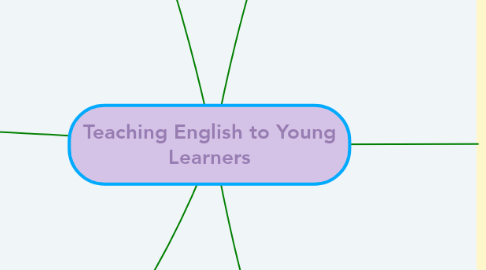
1. 4. Characteristics of young learners
1.1. Energetic and physically active
1.1.1. Kinesthetic activities
1.1.2. TPR method
1.2. Spontaneous and not afraid to participate
1.2.1. Songs, rhymes, chants, dialogs, etc.
1.3. Curious and receptive to new ideas
1.3.1. The Mystery Bag activity
1.4. Imaginative
1.4.1. Role-plays and charades
1.5. Easily distracted and with short attention spans
1.5.1. Brightly colored pictures, photos, pictures, visual aids, etc.
1.5.2. Long activities broken into smaller steps to check progression
1.6. Egocentric and relate ideas to themselves
1.6.1. Personalized activities
1.7. Social
1.7.1. Various types of interaction
2. 5. How children learn
2.1. By doing and interacting with their environment
2.1.1. Children are grounded in concrete objects and in what is happening here and now.
2.1.2. Children learn through own individual actions and exploration.
2.1.3. Teachers can resort to the use of realia.
2.2. With support and scaffolding by the teacher
2.2.1. Create interest in task
2.2.2. Simplify the task
2.2.3. Keep children on task
2.2.4. Model the task, including different ways of doing it
2.2.5. Control children frustration during the task
3. 6. How children learn languages
3.1. With a learning environment similar to first language acquisition
3.1.1. to meet immediate needs
3.1.2. to respond to their surroundings
3.2. Through lots of meaningful exposure and practice
3.2.1. comprehensible input
3.2.2. support by using visuals, realia, gestures, rate of speech, adjustement of language, rephrasing etc.
3.3. NOT through explicit grammatical explanations
4. 2. Reasons for an early start
4.1. The value of English for education and employment
4.1.1. English is the world´s lingua franca
4.2. The benefits of early language teaching
4.2.1. Optimal age: Critical period?
4.2.1.1. Little evidence to support it
4.2.2. Optimal conditions (inside and outside the classroom) for YL programs
4.2.2.1. The value of increased time
4.2.2.1.1. Amount of time: duration and intensity
4.2.2.2. The possibility of better pronunciation and fluency
4.2.2.2.1. Native-like pronunciation
4.2.2.2.2. Greater confidence to speak the language
4.2.2.2.3. Better oral proficiency
4.2.2.3. Greater global awareness and intercultural competence
4.2.2.3.1. Appreciation for their own, and other languages and cultures
4.2.2.4. The value of bilingualism
4.2.2.4.1. Mental flexibility
5. 1. Planning for succes in EYL
5.1. Effective EYL program models
5.1.1. Interaction, engaging activities and positive attitudes
5.1.1.1. FLEX programs
5.1.1.2. FLES programs
5.1.1.3. Immersion programs
5.1.1.4. Dual-language programs
5.1.1.5. Transitional and maintenance bilingual programs
5.2. Appropriately trained teachers
5.2.1. NNEST: non-native English speaking teacher
5.2.1.1. They share the learners´ language and culture, and understand the way children learn in that country.
5.2.2. NEST: native English speaking teacher
5.2.2.1. They add more resources and vocabulary, and show greater comfort to speak the language.
5.3. Culturally appropriate materials
5.3.1. Materials related to many cultures around the world
5.3.2. Appreciation of home culture
5.4. Continuity of curriculum between primary and secondary English
5.4.1. Smooth transition

